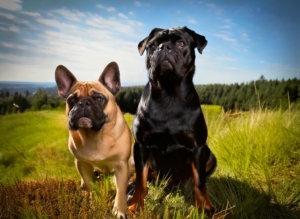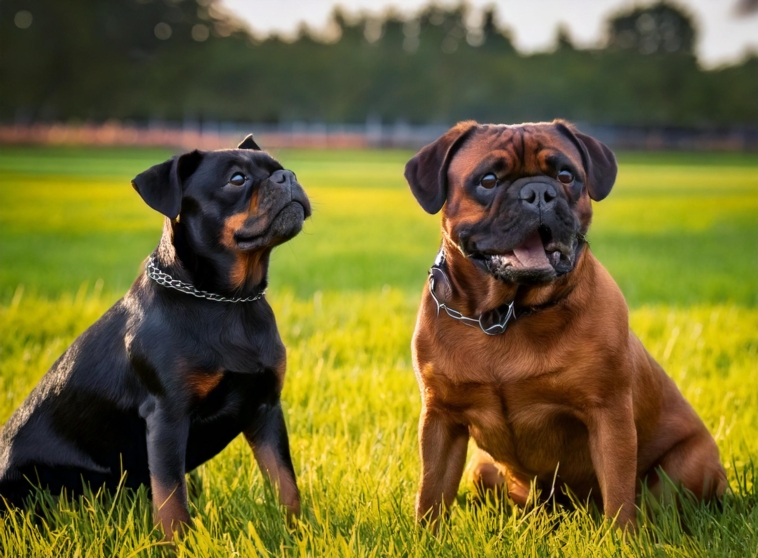Here’s an overview:
Introduction to Pug vs Doberman
Breed Histories and Backgrounds
Physical Characteristics: Size, Weight, and Appearance
Temperament and Personality Traits
Requirements for Activity and Exercise
Life Expectancy and Health Risks
Training and Socialization Needs of Pug and Doberman
Compatibility with Families and Kids
Living Conditions: Apartment vs House
Costs and Financial Considerations
Adoption And Breeder Related Aspects
Testimonials and Case Studies on Pug vs Doberman
Conclusion: Final Thoughts Pug vs Doberman
Introduction to Pug vs Doberman
Pugs:
Pugs are compact members of the toy breed. Their primary weakness is their broad nose and a large amount of excess skin on their faces in the syringes. They are a toy breed with a weight range of 14 to 18 pounds and have been around for quite a while as they first shone in China. Their calm, loving nature means they get along well with both children and adults.
Dobermans:
One of the most intelligent dogs in the world are Dobermans, or otherwise called Doberman Pinchers. These powerful German dogs can weigh in at 60-100 pounds, which can be hard to comprehend when you see how loveable they can be. A Doberman makes for a great family dog and loyal worker; they are famous for their guarding abilities and being loving. With dogs like these it’s important to socialize them as much as you can and train them regularly in order to have a well-adjusted dog.
Key Differences in Pug vs Dobermans:
- Size: Pugs are small, Dobermans are large.
- Temperament: Pugs are affectionate, Dobermans are protective.
- Care Needs: Pugs do not need a lot of exercise, Dobermans on the other hand require a lot of exercise.
Breed Histories and Backgrounds
Pug:
The Pug is known to be an ancient dog bred for royalty; their origin can be traced back to China where they first appeared during the Han Dynasty (206 BC–220 AD). They eventually found their way to Europe around the 16th century where they became popular with the nobles of that time. They are strongly built dogs known for their charming personality and pug nose.
Doberman:
Around the 19th century in Germany, Karl Friedrich created the Doberman. The original goal for this breed of dog was a combination of the best traits for both a guard and a family dog. For their robust, loyal, and intelligent traits a Doberman tail is well known. The look and attitude of a Doberman are quite noticeable, sleek and alert.
Physical Characteristics: Size, Weight, and Appearance
Pug:
- Size: Pugs are small animals, with an average height of around
10-12inches. - Weight: On average, a Pug weighs anywhere around `14-18 pounds.
- Appearance: They have compact bodies, with wrinkled faces, and curled tails. Their eyes are prominent as well as a short muzzle, and they are covered in a short smooth coat.
Doberman:
- Size: Dobermans have a height of about 24 – 28 inches when fully grown.
- Weight: The average weight of a Doberman is around
60-100pounds. - Appearance: The body of a Doberman is characterized as sleek and muscular, with the ears mostly cropped and the tail docked. The posture of this breed is alert and athletic. They can be found in a short exposed coat that is usually black with rust markings, blue, red, or fawn.
Temperament and Personality Traits
While Pugs form a vast amount of the most adorable and cute dogs, a Doberman is very much the opposite, and these two together build opposite personality types as well as temperament.
Pugs:
- Warm and out-going
- Fun-loving and cuddly
- Suitable for families with kids
- Can be raised in apartments.
- Prone to be the class clown or rascal.
Dobermans:
- Faithful and vengeful.
- Smart and easily molded.
- Good dogs for labor.
- Active and requires frequent workout.
- More suitable to people with prior experience.
There are these differences that make each one a unique companion. If you are looking for affection and laughter then Pugs are the perfect partner for you. Loving and dutiful, trained Doberman’s will be there beside you. One’s lifestyle and house should be assessed in order to choose the most appropriate one.
Requirements for Activity and Exercise
Pug:
- Daily Requirement: Figuring out the best workout did not take pug’s long. 30 minute workout daily is quite sufficient.
- Suitable Activities: light walks, fun times inside, or even some jogging could be fun.
Considerations:
- due to a tendency to overheat, pug’s be worked out during the night or early morning.
- due to the flatness of their face, they have a tendency to struggle with their breathing.
Doberman:
- Daily Requirement: Doberman’s on the other hand require heavy exercise of 60-90 minutes on a daily basis.
- Suitable Activities: Pugs love running, long walks, competitive training aimed at agility, and teaching them difficult commands.
Considerations:
- Doberman’s have high energy levels and require plenty of mental exercise.
- This breed is great for those that are active.
Grooming and Maintenance
The two dogs are very different, not just in appearance, but in grooming as well
- Pugs: Have a double coat of short hair that sheds regularly and needs to be groomed.
- Brushing: It’s advised to brush their hair between 2-3 times a week.
- Bathing: Every month, to stay clean and fresh.
- Face care: Ensure to maintain the facial creases if there are any to avoid some skin infections.
- Nails: Clip as needed whenever; there’s a requirement.
- Ears: Will require cleaning every week, to avoid wax build-up.
Doberman:
- Fur: Dobermans have a short, single coat which sheds very little.
- Brushing: This takes very little effort, one time in a week is enough.
- Baths: Bath them after every 6-8 weeks.
- Nails: Depending on the growth rate, they need to be clipped every 3-4 weeks.
- Ear cleaning: Like Pugs, this should also be done every week.
For both breeds, regular vet checkups are very vital.
Life Expectancy and Health Risks
Due to having a flat face or brachycephalic shape, Pugs develop quite a few problems with their breathing. Some health risks include the following:
- Brachycephalic obstructive airway syndrome being the most common.
- Hip dysplasia.
- Patellar luxation.
- Skin infections.
Doberman has some common health risks as well, owing to their big build:
- Dilated cardiomyopathy.
- Von Willebrand’s disease.
- Hip dysplasia.
- Hypothyroidism.
As for life expectancy:
- They usually range between 10-12 years of age.
- Pugs on the other hand will usually stay alive for 12-15 years.
Regular visits to the vet and having a balanced diet, along with appropriate exercise will allow them to live for longer.

Training and Socialization Needs of Pug and Doberman
The breeds have their socialization and training requirements that are distinctly different from one another.
Pug:
- Right from the pug stage, they will need to go through smooth and gentle training.
- The dog has shown improvement behavioral issues, especially when constant positive reinforcement is applied.
- It is important to note that behavioral socialization should take place as early as possible to avoid the troublesome results of not doing so.
The characteristics of the breed are such that they would be easier to manage even for the age of novices.
Doberman:
- The most demanding aspect of the Doberman is the consistent demanding training that he requires from you.
- Knowing the fact of only having to train a Doberman they are for sure higher learning intelligence fellow and would pick up the commands in no time.
- Of course the training would be incomplete without proper socializing as well from the owners to balance the temperament.
- It is best if you are an experienced owner as such an animal comes with a lot of energy that will require consistency.
Both the pugs and the Doberman require early on a lot of socialization and take it easy to adapt to their new environments well.
Compatibility with Families and Kids
If your family has a child, it would be ideal to have pug as family pet as they tend to be loving and gentle around children pugs are small so when playing with them they wouldn’t cause injury to a child either.
On the other hand Doberman’s are relatively bigger and also energetic which might be hard to be around small children without supervision but their reliable loyalty and protective instincts will benefit your family.
Important considerations:
Pugs:
- The pug tend to have lower energy levels and thus putting focuses on where he should be using it.
- Since the pug doesn’t required any advanced level of exercise he is comfortable living in apartments.
- He should have no trouble whatsoever getting along with other pets.
Doberman:
- People who choose a pug should be prepared to take them for walks quite regularly.
- There are some basics things that need to be done for training a pug for example proper socialization is a must
- They thrive in houses with big spaces as they are a big sized breed.
Living Conditions: Apartment vs House
In general, pugs are best to live in apartments. They’re small in stature and don’t need much exercise, which makes them apt for tight areas. They like being indoors and do not require much outdoor activity.
On the contrary, dobies thrive in houses with space to move around because they have a lot of energy and a great need for activity. A back yard is great for a doberman to exercise and spend time.
Key considerations:
- For pugs: Cramped spaces, high indoor activity.
- For Dobermans: Big spaces, active all day outside.
Because of these, the suitability of the breed to some form of accommodation will vary.
Costs and Financial Considerations
Now when we talk about cost factors in relation to having a Pug vs a Doberman, there are certain aspects which should be compare as well
Initial Purchase Price:
- Pug: costs between $600-$2000 on average.
- Doberman: costs between $1500-$4000 roughly.
Food Expenses:
- Pug: It eating less becomes a cost of about 300 a year.
- Doberman: Being bigger requires more food at an annual cost of around 800 dollars.
Healthcare Costs:
- Pug: Predominantly having difficulties breathing means a yearly bout about 400 dollars in average for the vet.
- Doberman: This breed has the possibility of developing heart ailments and may incur annual veterinary expenses of $600.
Training Costs:
- Pug: It usually requires basic training on manners, around $150.
- Doberman: Usually, it is necessary to train them and that can result in expenditures of $500.
Grooming: While both types have short hair, they still require grooming at least once a year which can be equal to roughly $150.
Adoption And Breeder Related Aspects
Pug vs Doberman, things to keep in mind while adopting or purchasing a Doberman and Pug:
- Reputable Breeders: Conduct a detailed research about all breeders on the availability of health certificates, breeding ethics, and references.
- Rescue Organizations: These are ones who relieve specific breeds from euthanasia, this usually gives a clear picture of the dog’s past.
- Lifestyle Compatibility: Make sure that the breed you choose is appropriate for the type of house and activity levels that you have.
- Cost: Take every cost into consideration such as the cost of purchase, care the need for socialization, the price of food, initial veterinary inspection.
Testimonials and Case Studies on Pug vs Doberman
Max, a pug, was great with children, according to his adoptive family from Ohio.
“Max is peaceful and full of love, children love him.” – Sarah R, Ohio
In the opposite manner, John an American from Texas appreciated his dog Doberman, Duke, for its vigilance and loyalty.
“Duke, an American Doberman, is an amazing guard dog and a great sweetheart.” – John K, Texas
A California couple has chosen a Pug for their stay as a pet in an apartment.
- Doesn’t need much exercise
- Is small in size
An Australian rancher praised his Doberman breed that he owns for being a good guardian.
- Protects livestock
- Very energetic and loves open space
Conclusion: Final Thoughts Pug vs Doberman
Considering the impact of the discussion considering the Pug vs Doberman discussion is very important. Each breed has its own pros and cons.
Things to remember:
Lifestyle Fit:
- Pugs are friendly companions that adapt quickly to an apartment and low activity level lifestyle.
- Dobermans require an active lifestyle and extra free space.
Their exercise requirements:
- For an ideal pug, a relaxed cruise of exercise is enough.
- Dobermans have a lot of energy and need to unleash through exercises that test their stamina.
The grooming standards:
- Components including pug face wrinkles need clean-ups to minimize hair loss.
- Dobermans are relatively low when it comes to grooming.
The training:
- Pugs can be very stubborn but with positive training their attitude changes rapidly.
- Dobermans are fast learners and are easy when it comes to honing Bollywood skills.




